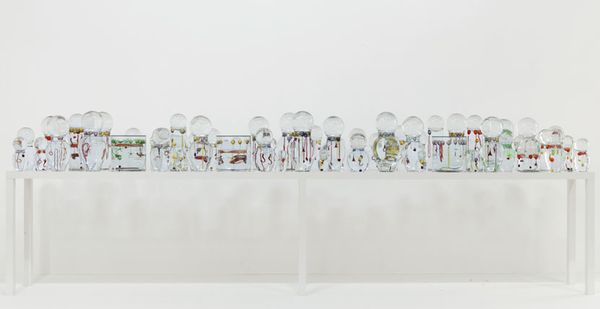Looking at Glass
Jean-Michel Othoniel has noted that he is fascinated and inspired by fragile glass objects that have survived for centuries, imbued with the unknown histories and desires of the people that have handled and protected them. We are fortunate to have in the collection many of the kinds of objects Othoniel likely had in mind, including an abundance of beautiful ancient blown-glass bottles, vases, and other vessels that date from the 1st century B.C.E. to the 6th century C.E. While glass was first “discovered” and used to create glazes and decorative objects approximately 5,000 years ago in Mesopotamia, it wasn’t until around the first century B.C.E. that craftsmen in the Eastern Mediterranean region developed the technique of glassblowing, which soon spread throughout the expanding Roman Empire. Unlike earlier processes, glassblowing was a relatively fast and versatile method that encouraged creativity and experimentation across a range of vessel shapes and styles.

Roman. Double Cosmetic Tube, 4th-5th century C.E. Glass, 5 1/8 x 1 1/16 x 1 7/8 in. (13 x 2.7 x 4.7 cm). Brooklyn Museum, Gift of Robert B. Woodward, 01.123.
Looking through our ancient holdings, my attention was immediately caught by the blown glass vessels used to hold perfumes, ointments, or eye makeup (kohl). These so-called cosmetic tubes have been found mainly in tombs, giving rise to the highly romantic and almost certainly false belief that they were used to collect the tears of mourners. They are thus sometimes referred to as lachrymatories—an erroneous historical designation that nonetheless creates an imaginative link between them and Othoniel’s work called Lagrimas (Tears), a collection of jars filled with small glass shapes floating in water.
His series of untitled blown-glass sculptures that hang from the gallery ceiling like overripe, seductive fruit also bear a distinct resemblance to these elongated and biomorphically-shaped cosmetic tubes. I wonder too if Othoniel had these ancient vessels in mind when he designed the new limited-edition bottle for Dior’s perfume, J’Adore. With its pendulous shape and spiraling trail of glass, this contemporary perfume bottle would not appear out of place among the toilette items of a wealthy 4th century C.E. Roman woman!

Roman. Double Cosmetic Tube with Ribbon Handles, 4th-6th century C.E. Glass, 3 1/8 x 1 1/8 x 5 1/16 in. (8 x 2.9 x 12.9 cm). Brooklyn Museum, Gift of Robert B. Woodward, 01.370.
The glass ribbons looped along the sides or encircling many of these cosmetic tubes might have been functional as well as decorative. Oils were an important component of ancient perfumes and makeup and this raised ornamentation would facilitate a grasp on what could become a slick surface.

Roemer, 1680-1700. Colorless glass, height: 9 9/16 in. (24.3 cm);. Brooklyn Museum, Gift of Wunsch Foundation, Inc., 2001.94.1.
A similar strategy is in play on this seventeenth-century roemer, a drinking glass common in Germany and the Netherlands (and frequently depicted in Dutch still-life paintings). Its base is punctuated by a series of textured glass beads called prunts that make a pleasing contrast to the smooth bowl. In an era when forks were not used regularly and cup handles weren’t common, prunts would help greasy hands maintain a grip on slippery glass. They remind me of permanent finger prints marking the spots where glass came in contact with flesh.
Nearly all of Othoniel’s works are informed by the aura or trace of a body: the oversized necklace as bodily surrogate, the implied occupant of an empty bed, glass shaped (or “wounded”) by a glassblower’s breath and touch. In this way, his poetic works resonate with centuries-old vessels and their intimate sensory connections to the long-vanished bodies that once held and used them.

Lisa Small joined the Brooklyn Museum in Spring 2011 as Curator of Exhibitions. From 2007 until 2011 she was Curator of Exhibitions at the American Federation of Arts (AFA), coordinating traveling exhibitions such as Turner to Cézanne: Masterpieces from the Davies Collection, National Museum Wales, and Gods and Heroes: Masterpieces from the École des Beaux-Arts, Paris. Prior to joining the AFA, Small was a curator at the Dahesh Museum of Art, where she organized numerous exhibitions, including Napoleon on the Nile: Soldiers, Artists, and the Rediscovery of Egypt and Fantasy & Faith: The Art of Gustave Doré. Small has taught art history at Hunter College and Brooklyn College and has been a member of the art history faculty at the School of Visual Arts since 2008. Small earned a B.A. from Colgate University, an M.A. and an M.Phil in Art History from CUNY, and an M.A. in Arts Administration from NYU.

